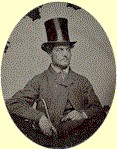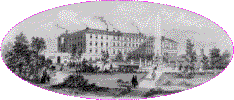The Newcastle-upon-Tyne Infirmary Turkish Baths
In 1858, the Newcastle-upon-Tyne Infirmary—it did not become Royal until the Queen's Golden Jubilee in 1887—was the first hospital in England to instal a Turkish bath. Like so many milestones in the bath’s history, this was due to the involvement of those connected with Urquhart’s foreign affairs committees—in this case George Crawshay and Sir John Fife.

In 1856, Crawshay was heavily subsidising the Sheffield Free Press, still owned by Isaac Ironside, but by now largely a mouthpiece for Urquhart’s political views and the Turkish Bath Movement. The paper was in financial difficulties and Crawshay went to discuss the matter with Urquhart who had been invited by Barter to stay at St Ann’s and advise on the building of the hydro’s first Turkish bath.
Crawshay was most impressed by what he saw, and on his return from Ireland built a private Turkish bath adjoining his Tynemouth house. He later related that it was ‘the first Turkish bath to be built in England since the days of the Romans'.6
However, unlike that built a few months later in Manchester, it was not open to the public.
Crawshay's claim was, in fact, incorrect since Isaac Ironside had built one at
his home in Walkley, Sheffield, several months earlier.16

But among those whom Crawshay invited to his bath was his
father-in-law, Sir John Fife, an ex-Chartist and, according to Urquhart’s wife Harriet, one of Urquhart’s oldest political co-operators.7 Fife was surgeon at the Newcastle-upon-Tyne Infirmary and one of the founders of its medical school. Just as Crawshay had been impressed by the bath at St Ann’s, so was Fife impressed—not only by the Turkish bath itself, but also by its
many therapeutic possibilities.
He wrote to Charles Attwood, another Urquhart supporter,
I have been restored to youth by being boiled, or rather roasted, alive in the bath of the Romans. It is one good thing done by Mr Urquhart, to bring this agent to us; and I am about to introduce it to the Infirmary.8
In November 1857, Fife reported on his bath experience in a talk to the Newcastle and Gateshead Pathological Society.9 Soon after, on the joint recommendation of Fife and Crawshay, the Infirmary’s House Committee approved the construction of a bath there.
The Infirmary's first Turkish bath
It was designed by the eminent local architect, John Dobson (1787-1865), who was responsible for the Infirmary's new wing, opened in 1855, and named the Dobson Wing after him.1

John Dobson
His earlier buildings included the city’s Northumberland Baths (1839) and the imposing Newcastle Central railway station (1850). The bath, which cost £60 to build and equip,9 was completed and functioning by July 1858.

The Dobson wing is on the left
When Dobson set to work, there was not yet any body of professional expertise on which he could draw. He therefore followed Barter’s practice of heating the bath by means of a Roman-style hypocaust. Yet the plan of Dobson’s bath shows it to have been different from Barter’s in several respects.

First, the hypocaust appears to run only under the sudatorium (the hottest room), so that the
tepidarium relies on ambient heat and the frigidarium is not heated at all. Perhaps as a result of this, or possibly by design, the room temperatures were lower than those usually found in a commercial establishment, with the
sudatorium ranging from 130 to 160 degrees Fahrenheit, and the tepidarium being maintained at 100 degrees.
Second, Barter believed that for optimal therapeutic effect the hot air in a Turkish bath should be as dry as possible; Dobson’s inclusion of a shower in the hot room goes against a fundamental principle, already generally accepted by designers of Victorian Turkish baths, that wet and dry areas should be separated.
Nevertheless, the medical staff were pleased with their bath, and Dr Andrew Bolton, in his House Surgeon’s report for 1859, seemed to be writing as much for house surgeons elsewhere as for his own house committee.
11,891 baths had been given during the year since it opened and, based on the experience gained, Bolton chose to pre-empt one of the standard contemporary objections to the bath—that it should not be taken by those with any sort of heart problem. He found that the extreme heat of the Turkish bath exerted less influence on the heart and circulation than an ordinary warm bath, remarking that,
in some cases in which the pulse and stethoscope give unmistakeable evidence of heart disease, such patients have undergone the [Turkish bath] process without attendant mischief, and with almost unlooked-for benefit.10
During the following year, from 1 January to 31 December 1861, 11,946 baths were given.11 The bath seemed to be working well, appeared to satisfy all the hospital’s medical expectations, and was widely visited by others wishing to follow suit. Not all the enquiries were from other hospitals.
When the Roman Bath Company was planning the Turkish bath which it intended to build in
Cambridge, the Secretary of the Company, Mr E F King, wrote to Bolton to ask for an account of its use at the infirmary.
Bolton replied, with an enthusiasm rather more glowing than might be expected in a sober medical assessment, that the first cases they had treated were,
of a rheumatic character, both acute and chronic,
lumbago, neuralgia, sciatica, and gout; and with such beneficial
results, that in the course of a few weeks the bath had become most
popular, and rheumatic cripples were being brought from all quarters;
some with their joints much swollen and suffering a martyrdom, were
conveyed helplessly down to a bath, into a species of Elysium, where
ache and pain vanished as by magic.3
Bolton’s reply enables us to calculate that 12,987 persons used the bath during the year ending 31 March 1861—a slightly different period from that in his annual report. And rather than giving King the actual total, he chose to provide the number of bathers grouped according as whether the baths were given to in-patients (1,720), out-patients (1,778), or to the overwhelming majority which he called ‘casuals’ (9,489). He does not say what is meant by ‘casuals’ but it seems highly likely that in addition to members of the public (who would have paid for a bath), some of the hospital staff were also included.
While confirming the benefits of using the bath, he also warns King about what to avoid in Cambridge. For the infirmary abandoned the hypocaust as a means of heating the bath when a number of bathers were burnt, usually after the clogs—which were intended to protect their feet—came off. The change became essential after a particularly serious accident when a bather fell onto the hot floor and was unable to get up quickly enough to avoid being seriously burned and when ‘life for a time was endangered.’
After this, the hot air was circulated in ducts around the walls of the bath, underneath the seating. But this too was quickly abandoned as the heated air became sweat-laden and there was no adequate ventilation.
The Infirmary's third Turkish bath
 Fortunately for the infirmary, Dr Bolton’s brother, Dr John Adams Bolton, previously an assistant surgeon at Newcastle, had opened a Turkish bath in Leicester the previous year. This had been designed by a local architect, Francis Drake, and was generally considered to be an improvement on existing baths.
Fortunately for the infirmary, Dr Bolton’s brother, Dr John Adams Bolton, previously an assistant surgeon at Newcastle, had opened a Turkish bath in Leicester the previous year. This had been designed by a local architect, Francis Drake, and was generally considered to be an improvement on existing baths.
Buoyed by his success, Drake placed advertisements in The Times, and a variety of local newspapers around the country, stating that he would,
be happy to PREPARE PLANS OF TURKISH BATHS, treated on entirely New Principles, as recently erected in Leicester, and which have been Patented, and completely remove all objections against the Turkish Baths as hitherto employed.12
In point of fact, although Drake designed the structure of the baths,
the new approach to heating was contrived by Dr John Adams Bolton
himself, and patented as An Improved Apparatus for Heating Turkish Baths, Public and Private Buildings, Vineries, Hothouses, and Cooking Ovens.13
In the Leicester establishment, fresh cold air was guided over heated metal plates covering the furnace so that the hot air was completely separated from the combustion fumes and smoke. The clean hot air then flowed in a continuous current through the hot rooms until it escaped outside the building through a grating.
Quite separately from this, the hot smoke from the furnace, on its way out through the chimney, was first diverted through floor-level ducts around the rooms and back again, so that
its heat could also be used. The ducts were partially hidden, being covered by cushioned benches which bathers could then sit or lie on.

In the infirmary’s Annual Report for 1864, which included a plan of the new baths, Dr Andrew Bolton commented that the Turkish bath had been favourably received by the medical profession. He added, rather over-optimistically, that its adoption by hospitals, asylums, and workhouses generally, seemed highly probable.
More realistically, he was convinced, after a three year trial, that the principle of circulating a continuous current of fresh heated air into the hot rooms had shown itself to be ‘superior in every respect’ to the methods adopted in the earlier baths.14
The Turkish bath was now open for patients three days in the week but, since the number of baths taken was no longer stated, it is not clear whether they were closed for the remainder of the week, or whether this was a period reserved for non-patients and staff.
We also learn something about how the bath was run and what its fuel cost. The furnace was heated by coke, which for the whole of the year 1863-4 cost £9.7s.0d. This was a great saving on the cost of the hypocaust because the rooms did not need to be kept hot at night. Firing the furnace at six in the morning ensured that the sudatorium would reach the desired 160 degrees by eleven o’clock. The furnace was then closed down and the heat was found to be sufficient for their bathing requirements for the rest of the day.
At some time between 1874 and 1883—we don’t know exactly when because both local collections of the house surgeon’s annual reports have gaps in their holdings—the infirmary stopped running the Turkish baths themselves and leased them to the Newcastle-upon-Tyne Turkish Bath Company Ltd.
This was the company which for many years owned and ran the Pilgrim Street Turkish Baths in the city centre. Significantly, one of its directors was Dr Charles John Gibb, the infirmary’s house surgeon from 1849 to 1855, and then an honorary surgeon till 1870.15
The infirmary’s annual reports for the years between 1884 and 1897 each include, in its statement of income and expenditure, the receipt of £300 'To One Year's Rent to 30 November...from Turkish Bath Co’. From this sum, income tax ranging from £7.0s.2d. (in 1884) to £10.0s.0d. (from 1895-7) had to be deducted.4
This convenient arrangement came to a halt at the end of 1897 when the Turkish bath company sold its Pilgrim Street Baths to William Priestley.5 It seems unlikely that the infirmary reverted to running the baths themselves, and they probably closed when Priestley took over. But even if this was not so, the infirmary moved into new buildings in 1906, and there is no mention of any Turkish baths on the new site.







